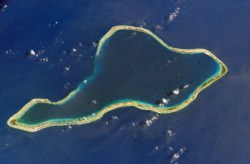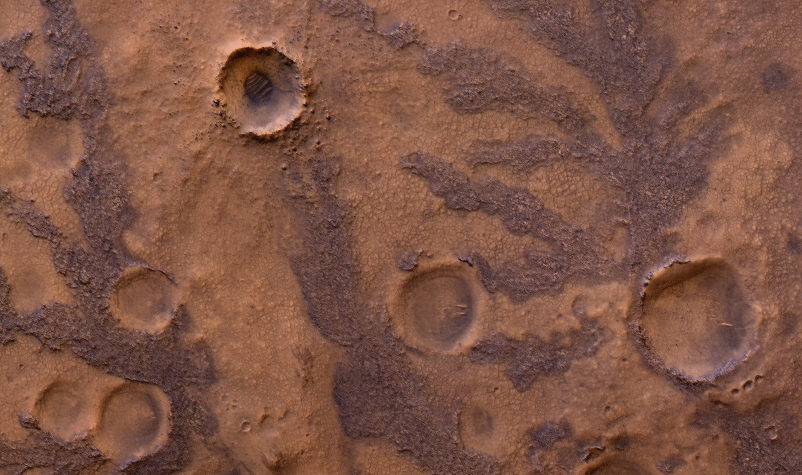HiRISE image of branching features in the floor of Antoniadi Crater thought to contain clay material. (NASA/JPL/University of Arizona)
In the hunt for evidence of a warmer, wetter past on Mars, clay deposits have been viewed as good indications that stable liquid water existed on its surface for some time — perhaps even long enough to allow life to develop. But new research conducted here on Earth shows that some clays don’t necessarily need lakes of liquid water to form. Instead they can be the result of volcanic activity, which is not nearly so hospitable to life.
 A research team led by Alain Meunier of the Université de Poitiers in France studied lavas containing iron and magnesium — similar to ancient clays identified on the surface of Mars — in the French Polynesian atoll of Moruroa. The team’s findings show that the same types of clay outcrops can be caused by the solidifying of water-rich magma in a volcanic environment, and don’t require Earthlike aquatic conditions at all.
A research team led by Alain Meunier of the Université de Poitiers in France studied lavas containing iron and magnesium — similar to ancient clays identified on the surface of Mars — in the French Polynesian atoll of Moruroa. The team’s findings show that the same types of clay outcrops can be caused by the solidifying of water-rich magma in a volcanic environment, and don’t require Earthlike aquatic conditions at all.
The results also correlate to the deuterium-to-hydrogen (D/H) ratio within clays found in Martian meteorites.
Read: Life from Mars Could Have Polluted Earth
“To crystallize, clays need water but not necessarily liquid water,” said Alain Meunier to the Agençe France-Presse (AFP). “Consequently, they cannot be used to prove that the planet was habitable or not during its early history.”
Additionally, the clay deposits found on Mars can be several hundred meters thick, which seems to be more indicative of upwelling magma than interactions with water.
“[This] new hypothesis proposes that the minerals instead formed during brief periods of magmatic degassing, diminishing the prospects for signs of life in these settings,” wrote Brian Hynek from the Department of Geological Sciences at the University of Colorado, in response to the paper by Meunier et al. which was published in the September 9 edition of the journal Nature Geoscience.
This does not necessarily mean that all Martian clays weren’t formed in the presence of water, however. Gale Crater — where NASA’s Curiosity rover is now exploring — could very well have been the site of a Martian lake, billions of years in the past. Clays found there could have been created by water.
Read: Take a Trip to Explore Gale Crater
According to Bethany Ehlmann of the California Institute of Technology, co-author of the study, “there are particular characteristics of texture” to clays formed under different conditions, and “Gale is a different flavor of Mars.”
Perhaps Curiosity will yet discover if Gale’s original flavor was more cool and wet than hot and spicy.
Read more on New Scientist and Cosmos Magazine.
Inset image: Moruroa Atoll (NASA)


Where does all the magmatic precipitation come from? Surely it assumes most of the water is was / still is underground. Where’s the evidence for this?
Analysis of Martian meteorites, for one: http://www.universetoday.com/95938/mars-has-watery-insides-just-like-earth/
..and long were those meteorites in space? That is’nt evidence of underground water on Mars. Just 50 and 300 ppm (parts per million) is similar to the amount of water within ‘dry’ sand. Supposition methinks.
MEthinks you need to forward your findings to the teams at the Université de Poitiers and the Carnegie Institute… don’t waste your time with them in the comments section of a space news blog!
I could be particularly vicious on this but I won’t. Different question. Why does the published article amazingly appear now? I thought Curiosity’s mission was to find evidence of this? All this story looks like is preemption, hoping to gain kudos before discovery!!
Please tell me, without the niggle, where there is the REAL evidence of the connection between ‘magmatic precipitation’ in this paper with a Martian mantle that is assumed full of water? You are just assuming that the clay pans were formed via flows between the core and mantle! This paper never exactly says this! (lcrowell below says this!)
At the risk of troll feeding, I’m not assuming anything, other than what the lead author of the paper explicitly stated. Namely, that clay deposits alone can’t be used to prove the presence of liquid water during the Noachian period. As seen in samples from the atoll (which today happens to be surrounded by ocean) iron-rich clays can be formed by magmatic outgassing. Again, Gale could be a different story, and in fact we hope it is.
As they say, at the risk of troll feeding:
– The subsurface ice is predicted out of observing water and its effects on Mars, from the same initial mantle content as Earth had to today’s water vapor and polar ice caps.
The disappearance of so much early water that seems to have been present is partly predicted by subsurface ice. The crustal conditions are suitable for it, Phoenix found subsurface ice, and vast areas where a northern ocean is predicted to have been present shows the subsurface hydrogen signature expected of buried ice.
The question among Mars scientists is now not if there is subsurface ice (not ascertained but the preliminary consensus). But if it is all frozen or if there is a habitable water table beneath several hundred meters of ice.
– As noted, the observed initial mantle water content of Mars is that of Earth and Moon. The problem with water on terrestrials is not to predict vast amounts of water but their relative dryness. Large classes of asteroids have much more water, ~ 10 %, vs the terrestrial content of ~ 0.05 %.
The absence of water problem may have gone away with updated models for protoplanetary disks, predicting that all Sun’s terrestrials should have the observed same water content. It seems rather generic as well:
“If it proves consistent, then we may have reconciled planet formation theory with the water-poor Earth: Regions of low turbulence in the protoplanetary disk allow formation of water-poor terrestrial planets.”
This is heartening, because the rather finetuned water content of habitability as we know it, having oceans but also land, may now have a satisfactorily answer. It may be common enough.
– Curiosity’s mission is not to find evidence for liquid water, the MERs established that. Its mission is to find evidence for or against the missing third piece of the energy sources (Sun) – liquid water – organics puzzle of martian habitability: organics.
Having placed a few claims out of field, maybe it behooves you to study up on Curiosity instead of feeling the need to be “vicious”. We are all students here, questions are good, but critical speculation isn’t all that informative when we know so little about specifics and so much about generics.
we know ice fell to the surface and some is still there locked and frozen.
we know it bubbled with lava and mud for some time and slowly froze and contracted.
that’s about it.
the story that stares you in the face on Mars is that nothing much happened on this iceball after it crystallized. the looming question: where’s the hotsprings?
None of this is proven… BTW.
Uhmmm… Isn’t a French Polynesian atoll an “Earthlike aquatic condition”?
There is enough sedimentary geology and geo-chemistry to indicate the presence of water in the past. Of course finding signal from noise can be hard, such as finding clay formed by water as distinguished from those formed by lava and magma. We have only orbital reconnaissance and ground observations at a few pinpoint locations. It is hard getting a comprehensive picture of things. Geologists are still working on that with Earth.
LC
Mars is starting to look more and more like a hybrid planet? That is to say, it may be half inner rocky planet and half cometary body? Water ices just below the surface? Meteoric or asteroid chain impacts melting large swaths of ice, thus causing intermittent local or global flooding? THEN the volcano pops off… and there’s more of the same? Sedimentation deposition studies will inform?
Alternate ways of (some) clays formation are good to know, but there are sufficient tests for models of early free water despite this in the form of fluid channels and coast lines correlated with subsurface ice remains. Only in combination with hypotheses of snowmelt from Mars’ chaotic orbit would this predict most features, except the arguable evidence for an early northern ocean.
On the contrary, the likelihood of early habitability could rise if we knew that volcanism was a recurring feature. It drives production of organics.
And geothermal driven hydrothermal vents have been predicted to be important both for organics and as providing a local redox energy source. This would most likely demand an ocean environment, but it is likely better to have evidence for vents and possible local water pools than evidence for oceans without vent formation.